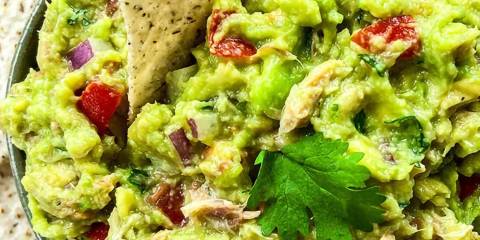If cans of tuna conjure up unpleasant memories of soggy school sandwiches, get ready to rethink the famous “chicken of the sea” and its other canned friends.
Tinned salmon, sardines, tuna, mackerel, and other varieties are not only nutritional powerhouses, they are also conveniently pre-cooked and shelf stable.
Not a bad choice when it comes to stocking the pantry for uncertain weather and other challenging life events.
Do You Eat Enough Fish?
Whether it’s because fish may not be readily available where someone lives, or whether it’s because there’s a fear of preparing it incorrectly, Americans aren’t consuming enough seafood.
Research shows about 90 percent of us don’t eat the suggested weekly amount of at least two servings of fish, one preferably being an oiler variety like salmon, sardines, trout, or mackerel.
Reasons to Eat Tinned Seafood
Here are some reasons why we should all be eating more tinned seafood.
-
It's Nutritious
Seafood is a good source of lean protein and offers key nutrients like omega 3s, vitamin D, and calcium.
A key part of the Mediterranean diet, fish is rich in healthy omega-3 fatty acids. This nutrient is known for being anti-inflammatory, helping to improve joint health, and offering protection against heart disease.
Canned seafood is an important and convenient source of omega 3s.
-
It's Budget-Friendly
Tinned seafood is a budget-friendly choice, especially when compared to other fresh and frozen varieties.
-
It Lasts on The Shelf or on The Go
Sealed in an airtight container, tinned fish lasts.
It can be used as a food source in emergency situations when refrigeration is an issue, or for camping, hiking, traveling, and picnicking adventures.
Cans of seafood can be stored for two to five years, depending on how the product was packaged and produced.
-
It's Versatile
A versatile ingredient, tinned fish can be found in many varieties:
- Common:
- tuna
- salmon
- anchovies
- sardines
- Specialty:
- trout
- mackerel
- mussels
- cod
- clams
- oysters
- octopus
- squid
- Common:
Choosing Your Tinned Seafood
Here are some things to look out for when purchasing tinned seafood.
-
Labeling
For the healthiest tinned seafood, look for the following:
- packed in:
- water
- extra-virgin olive oil
- a BPA-free can
- lower in:
- mercury
- sodium
- caught:
- wild-caught
- safe-caught
- sustainably
- packed in:
-
Sustainability
Many tinned seafood producers work with local fisheries and canneries to ensure their products follow sustainable fishing practices.
Look for the following terms on the label:
- pole-caught
- troll-caught
- school-caught
- FAD-free
If there’s no information on how the product was harvested, it could mean an unsustainable method was used.
-
Mercury Content
Most fish contains some amounts of mercury.
Risk Factors
For many people, the exposure risk is not too much of a concern. However, pregnant women and young children can be harmed from higher levels of this pollutant.
Limiting Mercury
To ease concerns regarding mercury contents, be aware of the different varieties.
-
Lower-Mercury Fish
These varieties that tend to be lower in mercury:
- skipjack (a.k.a. “light” or “chunk light”)
- wild Atlantic salmon
- pink salmon
- Atlantic mackerel
- Atlantic sardines in oil
-
Higher-Mercury Fish
Consume these less frequently to avoid mercury:
- albacore (white) tuna
- yellowfin tuna
- king mackerel
-
-
Sodium Content
Canned seafood can be high in sodium. So if you’re watching your intake, look for low-sodium varieties.
-
Water-Packed vs. Oil-Packed
Water-packed tinned seafood is typically better for you than versions packed in oil, unless the oil is extra-virgin olive.
Package Integrity
Avoid purchasing cans of seafood that have bulges, leaks, or dents. The product within may be contaminated.
How to Use Those Tins
Opening a can of seafood is easy, but what can you do with it besides making a sandwich or eating it straight from the tin?
-
For Charcuterie
Look to what some restaurants are doing: they’re replacing high-saturated fat items (cured meats, pâtés) on expensive charcuterie boards with high-quality tinned fish.
Try it yourself by accompanying your favorite canned seafood with an assortment of mustards, cornichons, olives, pickles, minced red onion, and capers.
-
As Toppings
-
Anchovies
Add canned anchovies to dressings, Caesar salad, or pizza.
-
Clams / Mussels
Tinned mussels or clams add flavorful protein to salads and pastas.
-
Salmon
Use canned salmon in salmon burgers and sushi rolls, or mix it into salads.
-
Sardines
Canned sardines are good atop crackers and in rice dishes or pasta sauces.
-
Trout
Try tinned trout as an ingredient blended into dips and spreads.
-
Tuna
Tinned tuna can, of course, be made into sandwiches (try a tuna melt!).
But it can also be added to casseroles, green salads, and pasta dishes.
-
-
Storing Opened Cans
Store opened and uneaten portions of tinned seafood in an airtight container in the fridge. Enjoy within a few days.











